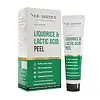What's inside
What's inside
 Key Ingredients
Key Ingredients

 Benefits
Benefits

 Concerns
Concerns

 Ingredients Side-by-side
Ingredients Side-by-side

Water
Skin ConditioningLactic Acid
BufferingGlycerin
HumectantPolyacrylate Crosspolymer-6
Emulsion StabilisingNiacinamide
SmoothingSodium Hydroxide
BufferingXylitylglucoside
HumectantAnhydroxylitol
HumectantXylitol
HumectantDipotassium Glycyrrhizate
HumectantChamomilla Vulgaris Extract
Skin ProtectingCalendula Officinalis Extract
Skin ConditioningAloe Barbadensis Leaf Extract
EmollientPhenoxyethanol
PreservativeSodium Cocoyl Amino Acids
CleansingSarcosine
Skin ConditioningPotassium Aspartate
Skin ConditioningMagnesium Aspartate
Skin ConditioningAcacia Senegal Gum
MaskingXanthan Gum
EmulsifyingDisodium EDTA
Allantoin
Skin ConditioningWater, Lactic Acid, Glycerin, Polyacrylate Crosspolymer-6, Niacinamide, Sodium Hydroxide, Xylitylglucoside, Anhydroxylitol, Xylitol, Dipotassium Glycyrrhizate, Chamomilla Vulgaris Extract, Calendula Officinalis Extract, Aloe Barbadensis Leaf Extract, Phenoxyethanol, Sodium Cocoyl Amino Acids, Sarcosine, Potassium Aspartate, Magnesium Aspartate, Acacia Senegal Gum, Xanthan Gum, Disodium EDTA, Allantoin
Water
Skin ConditioningKaolin
AbrasiveGlycerin
HumectantBentonite
AbsorbentMontmorillonite
AbsorbentPEG-8
HumectantPolysorbate 20
EmulsifyingPPG-33 Butyl Ether
Skin ConditioningPropylene Glycol
HumectantPhenoxyethanol
PreservativeEthylhexylglycerin
Skin ConditioningOctenidine Hcl
AntimicrobialSalicylic Acid
MaskingCitric Acid
BufferingCoco-Glucoside
CleansingCentella Asiatica Extract
CleansingCamellia Sinensis Leaf Extract
AntimicrobialAzadirachta Indica Leaf Oil
MaskingCalophyllum Inophyllum Seed Oil
AntimicrobialEucalyptus Globulus Leaf Oil
PerfumingLactobacillus/Pear Juice Ferment Filtrate
Skin ConditioningPhellodendron Amurense Bark Extract
Skin ConditioningSalix Alba Bark Extract
AstringentRehmannia Chinensis Root Extract
Skin ConditioningScutellaria Baicalensis Root Extract
AstringentHouttuynia Cordata Extract
Skin ConditioningGlycine Soja Seed Extract
Skin ConditioningMenthol
MaskingXanthan Gum
EmulsifyingStearyl Dimethicone
EmollientOctadecene
SolventSodium Caproyl/Lauroyl Lactylate
AntimicrobialTriethyl Citrate
MaskingDisodium EDTA
CI 77288
Cosmetic ColorantWater, Kaolin, Glycerin, Bentonite, Montmorillonite, PEG-8, Polysorbate 20, PPG-33 Butyl Ether, Propylene Glycol, Phenoxyethanol, Ethylhexylglycerin, Octenidine Hcl, Salicylic Acid, Citric Acid, Coco-Glucoside, Centella Asiatica Extract, Camellia Sinensis Leaf Extract, Azadirachta Indica Leaf Oil, Calophyllum Inophyllum Seed Oil, Eucalyptus Globulus Leaf Oil, Lactobacillus/Pear Juice Ferment Filtrate, Phellodendron Amurense Bark Extract, Salix Alba Bark Extract, Rehmannia Chinensis Root Extract, Scutellaria Baicalensis Root Extract, Houttuynia Cordata Extract, Glycine Soja Seed Extract, Menthol, Xanthan Gum, Stearyl Dimethicone, Octadecene, Sodium Caproyl/Lauroyl Lactylate, Triethyl Citrate, Disodium EDTA, CI 77288
Ingredients Explained
These ingredients are found in both products.
Ingredients higher up in an ingredient list are typically present in a larger amount.
Disodium EDTA plays a role in making products more stable by aiding other preservatives.
It is a chelating agent, meaning it neutralizes metal ions that may be found in a product.
Disodium EDTA is a salt of edetic acid and is found to be safe in cosmetic ingredients.
Learn more about Disodium EDTAGlycerin is already naturally found in your skin. It helps moisturize and protect your skin.
A study from 2016 found glycerin to be more effective as a humectant than AHAs and hyaluronic acid.
As a humectant, it helps the skin stay hydrated by pulling moisture to your skin. The low molecular weight of glycerin allows it to pull moisture into the deeper layers of your skin.
Hydrated skin improves your skin barrier; Your skin barrier helps protect against irritants and bacteria.
Glycerin has also been found to have antimicrobial and antiviral properties. Due to these properties, glycerin is often used in wound and burn treatments.
In cosmetics, glycerin is usually derived from plants such as soybean or palm. However, it can also be sourced from animals, such as tallow or animal fat.
This ingredient is organic, colorless, odorless, and non-toxic.
Glycerin is the name for this ingredient in American English. British English uses Glycerol/Glycerine.
Learn more about GlycerinPhenoxyethanol is a preservative that has germicide, antimicrobial, and aromatic properties. Studies show that phenoxyethanol can prevent microbial growth. By itself, it has a scent that is similar to that of a rose.
It's often used in formulations along with Caprylyl Glycol to preserve the shelf life of products.
Water. It's the most common cosmetic ingredient of all. You'll usually see it at the top of ingredient lists, meaning that it makes up the largest part of the product.
So why is it so popular? Water most often acts as a solvent - this means that it helps dissolve other ingredients into the formulation.
You'll also recognize water as that liquid we all need to stay alive. If you see this, drink a glass of water. Stay hydrated!
Learn more about WaterXanthan gum is used as a stabilizer and thickener within cosmetic products. It helps give products a sticky, thick feeling - preventing them from being too runny.
On the technical side of things, xanthan gum is a polysaccharide - a combination consisting of multiple sugar molecules bonded together.
Xanthan gum is a pretty common and great ingredient. It is a natural, non-toxic, non-irritating ingredient that is also commonly used in food products.
Learn more about Xanthan Gum